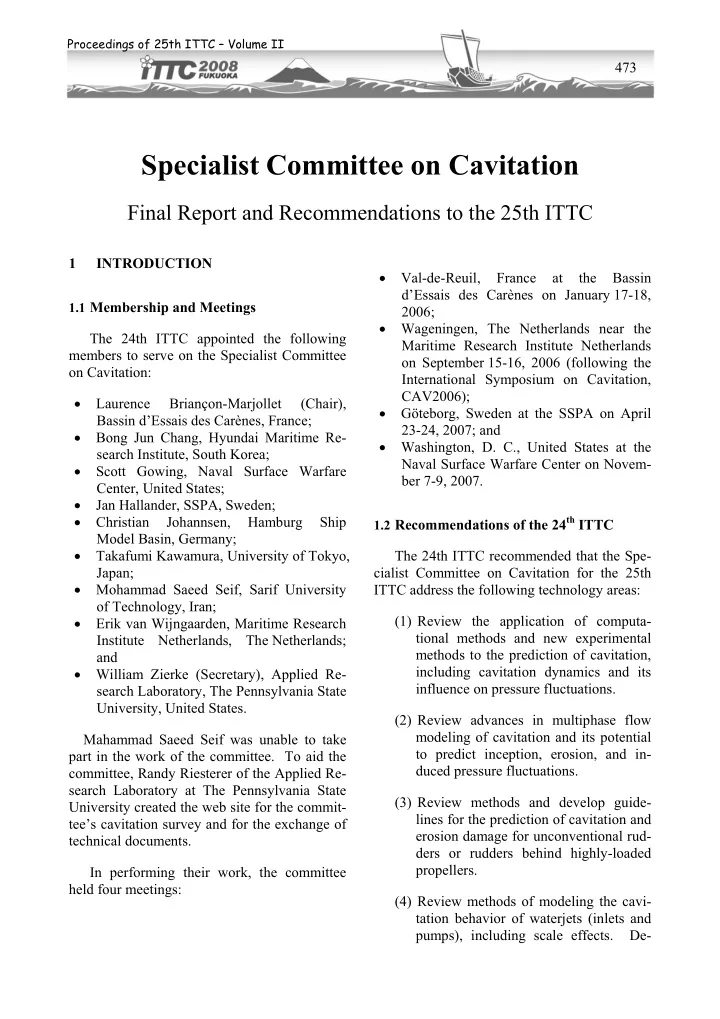

Proceedings of 25th ITTC – Volume II 473 Specialist Committee on Cavitation Final Report and Recommendations to the 25th ITTC 1 INTRODUCTION • Val-de-Reuil, France at the Bassin d’Essais des Carènes on January 17-18, 1.1 Membership and Meetings 2006; • Wageningen, The Netherlands near the The 24th ITTC appointed the following Maritime Research Institute Netherlands members to serve on the Specialist Committee on September 15-16, 2006 (following the on Cavitation: International Symposium on Cavitation, CAV2006); • Laurence Briançon-Marjollet (Chair), • Göteborg, Sweden at the SSPA on April Bassin d’Essais des Carènes, France; 23-24, 2007; and • Bong Jun Chang, Hyundai Maritime Re- • Washington, D. C., United States at the search Institute, South Korea; Naval Surface Warfare Center on Novem- • Scott Gowing, Naval Surface Warfare ber 7-9, 2007. Center, United States; • Jan Hallander, SSPA, Sweden; • Christian Johannsen, Hamburg Ship 1.2 Recommendations of the 24 th ITTC Model Basin, Germany; • Takafumi Kawamura, University of Tokyo, The 24th ITTC recommended that the Spe- Japan; cialist Committee on Cavitation for the 25th • Mohammad Saeed Seif, Sarif University ITTC address the following technology areas: of Technology, Iran; (1) Review the application of computa- • Erik van Wijngaarden, Maritime Research tional methods and new experimental Institute Netherlands, The Netherlands; methods to the prediction of cavitation, and including cavitation dynamics and its • William Zierke (Secretary), Applied Re- influence on pressure fluctuations. search Laboratory, The Pennsylvania State University, United States. (2) Review advances in multiphase flow modeling of cavitation and its potential Mahammad Saeed Seif was unable to take to predict inception, erosion, and in- part in the work of the committee. To aid the duced pressure fluctuations. committee, Randy Riesterer of the Applied Re- search Laboratory at The Pennsylvania State (3) Review methods and develop guide- University created the web site for the commit- lines for the prediction of cavitation and tee’s cavitation survey and for the exchange of erosion damage for unconventional rud- technical documents. ders or rudders behind highly-loaded propellers. In performing their work, the committee held four meetings: (4) Review methods of modeling the cavi- tation behavior of waterjets (inlets and pumps), including scale effects. De-
Specialist Committee on Cavitation 474 cated that the field of cavitation modeling is velop guidelines or procedures. Liaise with the Propulsion Committee. still not in a fully-matured stage of develop- ment, no matter which modeling technique is used. The empirical and potential-flow meth- 2 CAVITATION SURVEY ods seem to have reached the stage where the accuracy is reasonable enough for trade-off The 25th ITTC Specialist Committee on studies, perhaps with the exception of predict- Cavitation has been tasked to determine the ing cavitation noise and cavitation erosion. The status of cavitation modeling—with specific responding organizations rank the maturity of questions related to multiphase flow modeling, computational fluid dynamics (CFD) codes to rudders, and waterjets. In order to fairly ad- be somewhat lower. Again, they feel that pre- dress the state of the art of cavitation modeling, dicting cavitation erosion is the most difficult the committee wanted to survey the opinions of task. the worldwide cavitation community. The committee developed survey questions in the Clearly, the organizations that develop CFD codes had more faith in the absolute accu- following areas: racy of these types of codes than the organiza- • Background Information, tions who are only CFD users. In general, the • Cavitation Modeling Capability, responding groups already feel that the CFD • codes offer a good alternative to boundary- Cavitation Experimental Capability, • element codes. However, for all of the model- Rudder Cavitation, ing methods, the survey indicated a large scat- • Waterjet Cavitation, and ter in the judgment of the accuracy for cavita- • Summary Information. tion predictions—which is not surprising, given the very limited availability of quantita- 2.1 Survey: Background Information tive validation data. In June of 2006, the committee sent e-mail For trade-off studies and scaling, all of the responding organizations utilize empirical messages to 179 organizations—including modeling, based on both model-scale and full- ITTC members and other specifically- scale test results—as well as theoretical formu- identified organizations who deal with cavita- lations. For instance, empirical models for the tion—which asked them to go to a web site es- inception of vortex cavitation are based on tablished by the committee and answer as some modified form of the formula developed many of the survey questions as they felt able by McCormick (1962). Other empirical models to complete. 29 organizations from 14 coun- attempt to account for nuclei population, ther- tries completed the survey—with responses modynamic effects, bubble interactions, pres- from Australia, China, Finland, France, Ger- sure fluctuations, cavitation thrust breakdown, many, Italy, Japan, The Netherlands, Poland, cavitation erosion, and cavitation noise. Some Russia, South Korea, Sweden, Turkey, and the groups use a combination of empirical models United States. and viscous CFD computations. Most of the responding organizations util- 2.2 Survey: Cavitation Modeling Capability ize potential-flow methods, primarily for sheet cavitation. These groups used a mixture of All but one of the responding organizations their own codes, developed by other groups, perform numerical and/or empirical modeling and modified codes. to predict cavitation performance. In the survey, the committee asked these organizations to Sixteen of the 29 responding organizations quantify the accuracy of certain modeling that perform cavitation modeling, use commer- techniques to predict various types of cavita- cial CFD software. For single-phase flow, tion phenomena. In general, the responses indi-
Recommend
More recommend